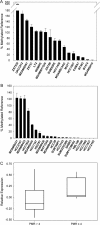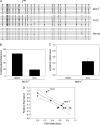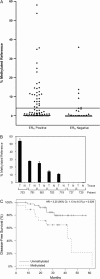Epigenetic repression of the estrogen-regulated Homeobox B13 gene in breast cancer
- PMID: 18499701
- PMCID: PMC2899848
- DOI: 10.1093/carcin/bgn115
Epigenetic repression of the estrogen-regulated Homeobox B13 gene in breast cancer
Abstract
Several studies have reported that a high expression ratio of HOXB13 to IL17BR predicts tumor recurrence in node-negative, estrogen receptor (ER) alpha-positive breast cancer patients treated with tamoxifen. The molecular mechanisms underlying this dysregulation of gene expression remain to be explored. Our epigenetic analysis has found that increased promoter methylation of one of these genes, HOXB13, correlate with the decreased expression of its transcript in breast cancer cell lines (P < 0.005). Transcriptional silencing of this gene can be reversed by a demethylation treatment. HOXB13 is suppressed by the activation of estrogen signaling in ERalpha-positive breast cancer cells. However, treatment with 4-hydroxytamoxifen (4-OHT), an antiestrogen, abrogates the ERalpha-mediated suppression in cancer cells. The notion that this transcriptional induction of HOXB13 occurs in vitro with simultaneous exposure to both estrogen and 4-OHT may provide a biological explanation for its aberrant expression in many node-negative patients undergoing tamoxifen therapy. Interestingly, promoter hypermethylation of HOXB13 is more frequently observed in ERalpha-positive patients with increased lymph node metastasis (P = 0.031) and large tumor sizes (>5 cm) (P = 0.008). In addition, this aberrant epigenetic event is associated with shorter disease-free survival (P = 0.029) in cancer patients. These results suggest that hypermethylation of HOXB13 is a late event of breast tumorigenesis and a poor prognostic indicator of node-positive cancer patients.
Figures




Similar articles
-
The prognostic biomarkers HOXB13, IL17BR, and CHDH are regulated by estrogen in breast cancer.Clin Cancer Res. 2007 Nov 1;13(21):6327-34. doi: 10.1158/1078-0432.CCR-07-0310. Clin Cancer Res. 2007. PMID: 17975144
-
The HOXB13:IL17BR expression index is a prognostic factor in early-stage breast cancer.J Clin Oncol. 2006 Oct 1;24(28):4611-9. doi: 10.1200/JCO.2006.06.6944. J Clin Oncol. 2006. PMID: 17008703
-
HOXB13-to-IL17BR expression ratio is related with tumor aggressiveness and response to tamoxifen of recurrent breast cancer: a retrospective study.J Clin Oncol. 2007 Feb 20;25(6):662-8. doi: 10.1200/JCO.2006.07.3676. J Clin Oncol. 2007. PMID: 17308270
-
Epigenetic regulation of estrogen signaling in breast cancer.Epigenetics. 2013 Mar;8(3):237-45. doi: 10.4161/epi.23790. Epub 2013 Jan 30. Epigenetics. 2013. PMID: 23364277 Free PMC article. Review.
-
HOXB13 in cancer development: molecular mechanisms and clinical implications.Front Med. 2025 Jun;19(3):439-455. doi: 10.1007/s11684-024-1119-x. Epub 2025 Mar 11. Front Med. 2025. PMID: 40067581 Review.
Cited by
-
HOXB13, a target of DNMT3B, is methylated at an upstream CpG island, and functions as a tumor suppressor in primary colorectal tumors.PLoS One. 2010 Apr 29;5(4):e10338. doi: 10.1371/journal.pone.0010338. PLoS One. 2010. Retraction in: PLoS One. 2022 Oct 19;17(10):e0276670. doi: 10.1371/journal.pone.0276670. PMID: 20454457 Free PMC article. Retracted.
-
Estrogen receptor α-coupled Bmi1 regulation pathway in breast cancer and its clinical implications.BMC Cancer. 2014 Feb 24;14:122. doi: 10.1186/1471-2407-14-122. BMC Cancer. 2014. PMID: 24559156 Free PMC article.
-
Analysis of HOX gene expression patterns in human breast cancer.Mol Biotechnol. 2014 Jan;56(1):64-71. doi: 10.1007/s12033-013-9682-4. Mol Biotechnol. 2014. PMID: 23820980
-
The role of HOXB9 and miR-196a in head and neck squamous cell carcinoma.PLoS One. 2015 Apr 10;10(4):e0122285. doi: 10.1371/journal.pone.0122285. eCollection 2015. PLoS One. 2015. PMID: 25860510 Free PMC article.
-
Discovery of novel hypermethylated genes in prostate cancer using genomic CpG island microarrays.PLoS One. 2009;4(3):e4830. doi: 10.1371/journal.pone.0004830. Epub 2009 Mar 13. PLoS One. 2009. PMID: 19283074 Free PMC article.
References
-
- Osborne CK, et al. Estrogen receptor: current understanding of its activation and modulation. Clin. Cancer Res. 2001;7:4338s–4342s. - PubMed
-
- Ma XJ, et al. A two-gene expression ratio predicts clinical outcome in breast cancer patients treated with tamoxifen. Cancer Cell. 2004;5:607–616. - PubMed
-
- Goetz MP, et al. A two-gene expression ratio of homeobox 13 and interleukin-17B receptor for prediction of recurrence and survival in women receiving adjuvant tamoxifen. Clin. Cancer Res. 2006;12:2080–2087. - PubMed
-
- Ma X-J, et al. The HOXB13:IL17BR expression index is a prognostic factor in early-stage breast cancer. J. Clin. Oncol. 2006;24:4611–4619. - PubMed
-
- Jansen MPHM, et al. HOXB13-to-IL17BR expression ratio is related with tumor aggressiveness and response to tamoxifen of recurrent breast cancer: a retrospective study. J. Clin. Oncol. 2007;25:662–668. - PubMed
Publication types
MeSH terms
Substances
Grants and funding
LinkOut - more resources
Full Text Sources
Other Literature Sources
Medical
Molecular Biology Databases
Research Materials

